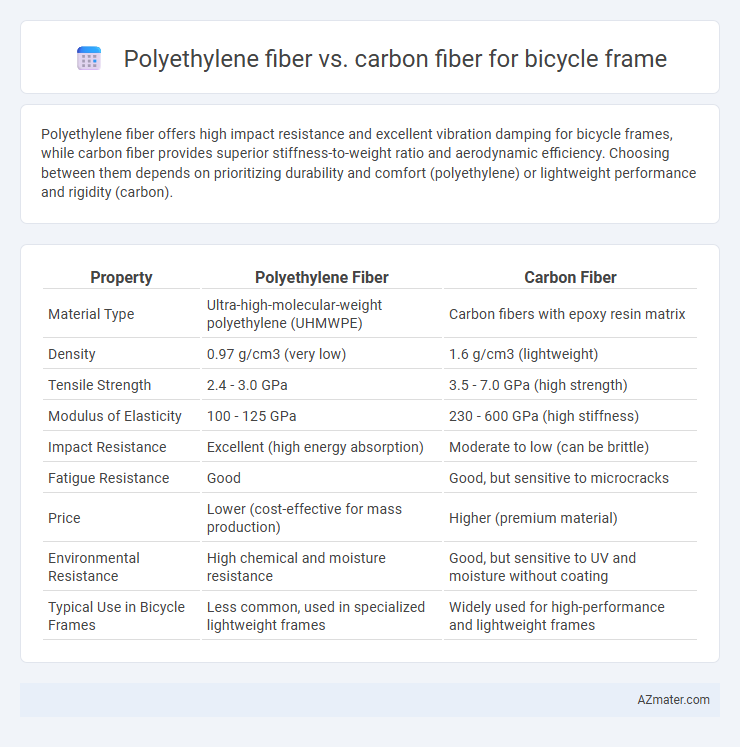Polyethylene fiber offers high impact resistance and excellent vibration damping for bicycle frames, while carbon fiber provides superior stiffness-to-weight ratio and aerodynamic efficiency. Choosing between them depends on prioritizing durability and comfort (polyethylene) or lightweight performance and rigidity (carbon).
Table of Comparison
| Property | Polyethylene Fiber | Carbon Fiber |
|---|---|---|
| Material Type | Ultra-high-molecular-weight polyethylene (UHMWPE) | Carbon fibers with epoxy resin matrix |
| Density | 0.97 g/cm3 (very low) | 1.6 g/cm3 (lightweight) |
| Tensile Strength | 2.4 - 3.0 GPa | 3.5 - 7.0 GPa (high strength) |
| Modulus of Elasticity | 100 - 125 GPa | 230 - 600 GPa (high stiffness) |
| Impact Resistance | Excellent (high energy absorption) | Moderate to low (can be brittle) |
| Fatigue Resistance | Good | Good, but sensitive to microcracks |
| Price | Lower (cost-effective for mass production) | Higher (premium material) |
| Environmental Resistance | High chemical and moisture resistance | Good, but sensitive to UV and moisture without coating |
| Typical Use in Bicycle Frames | Less common, used in specialized lightweight frames | Widely used for high-performance and lightweight frames |
Introduction to Bicycle Frame Materials
Polyethylene fiber and carbon fiber are both advanced materials used in bicycle frame construction, offering distinct advantages in strength-to-weight ratio and durability. Carbon fiber provides exceptional stiffness and lightweight performance, making it ideal for competitive cycling and high-performance frames, while polyethylene fiber offers superior impact resistance and flexibility, enhancing durability for casual or off-road riding. Understanding the mechanical properties and manufacturing processes of these fibers is crucial for selecting the right material tailored to specific cycling needs and riding styles.
Overview of Polyethylene Fiber
Polyethylene fiber, particularly ultra-high-molecular-weight polyethylene (UHMWPE), offers exceptional tensile strength and impact resistance for bicycle frames, making it lightweight and highly durable. It has excellent vibration damping properties, providing a smoother ride compared to stiffer materials like carbon fiber. While polyethylene fiber frames are less stiff than carbon fiber, their superior toughness and resistance to fatigue make them ideal for absorbing shocks and preventing frame damage under stress.
Overview of Carbon Fiber
Carbon fiber is a high-performance material favored in bicycle frame manufacturing due to its exceptional strength-to-weight ratio and stiffness, enabling lightweight yet durable frames that enhance speed and handling. Composed of thin strands of carbon atoms bonded together in a crystalline formation, carbon fiber provides superior resistance to fatigue and corrosion compared to polyethylene fiber, making it ideal for long-term use in demanding cycling conditions. The ability to mold carbon fiber into complex aerodynamic shapes offers designers unparalleled flexibility in optimizing frame geometry for maximum efficiency and rider comfort.
Weight Comparison: Polyethylene vs Carbon Fiber
Polyethylene fiber generally weighs more than carbon fiber when used in bicycle frames, with typical densities around 0.97 g/cm3 compared to carbon fiber's 1.6 g/cm3, but carbon fiber's superior strength-to-weight ratio enables lighter overall frame designs. Carbon fiber frames can be engineered to achieve lower weights without sacrificing stiffness or durability, making them preferred for high-performance bicycles. Polyethylene frames tend to be heavier and bulkier, which may impact acceleration and handling in competitive cycling.
Strength and Durability Differences
Polyethylene fiber, known for its high impact resistance and flexibility, offers excellent durability in bicycle frames but typically exhibits lower tensile strength compared to carbon fiber. Carbon fiber provides superior strength-to-weight ratio and stiffness, making it ideal for high-performance frames that require rigidity and responsiveness. However, carbon fiber is more prone to catastrophic failure under extreme impact, whereas polyethylene fiber can absorb shocks better, enhancing overall frame longevity.
Flexibility and Ride Comfort
Polyethylene fiber offers superior flexibility and enhanced ride comfort due to its high damping properties, absorbing road vibrations effectively compared to the stiffer carbon fiber. Carbon fiber frames provide exceptional stiffness and power transfer but often result in a harsher ride, transmitting more road feedback to the rider. For cyclists prioritizing smoothness and shock absorption, polyethylene fiber frames deliver a more comfortable experience on varied terrains.
Cost Analysis: Affordability and Value
Polyethylene fiber offers a more budget-friendly option for bicycle frames, often costing significantly less per kilogram compared to carbon fiber, making it accessible for entry-level and mid-range bikes. Carbon fiber frames, while expensive upfront, provide superior strength-to-weight ratio and durability, potentially offering better long-term value for performance cyclists despite higher initial costs. Evaluating total cost of ownership includes factoring in repair costs, with polyethylene frames typically easier and cheaper to maintain, whereas carbon fiber requires specialized repair skills that can increase expenses.
Environmental Impact and Sustainability
Polyethylene fiber, such as Ultra-High-Molecular-Weight Polyethylene (UHMWPE), offers a lower environmental impact due to its recyclability and energy-efficient production compared to carbon fiber, which relies heavily on energy-intensive carbonization processes and non-renewable petroleum resources. Carbon fiber frames, while lightweight and durable, present significant challenges in recycling and disposal, contributing to environmental pollution through landfill accumulation and incineration emissions. The sustainability of polyethylene fiber bicycle frames is enhanced by their biodegradability potential and reduced carbon footprint throughout the manufacturing lifecycle.
Maintenance and Longevity
Polyethylene fiber bicycle frames are highly resistant to corrosion and require minimal maintenance due to their chemical stability and impact resistance. Carbon fiber frames offer superior stiffness and lightweight performance but demand careful inspection for cracks and damage, as repairs can be complex and costly. Both materials provide excellent longevity, but polyethylene fibers typically endure harsh environmental conditions better without significant degradation over time.
Which Fiber is Best for Your Bicycle Frame?
Polyethylene fiber, known for its exceptional impact resistance and lightweight properties, offers superior vibration damping making it ideal for comfort-oriented bicycle frames. Carbon fiber excels in stiffness and strength-to-weight ratio, providing high performance and responsive handling suited for racing and competitive cycling. Choosing between polyethylene and carbon fiber depends on your riding style, with polyethylene favoring durability and comfort, while carbon fiber prioritizes speed and rigidity.

Infographic: Polyethylene fiber vs Carbon fiber for Bicycle frame
 azmater.com
azmater.com